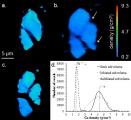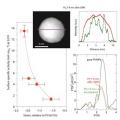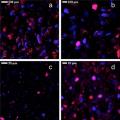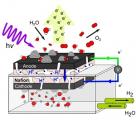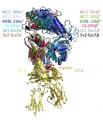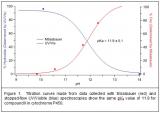Responsible, eco-friendly and sustainable use of energy is one of the biggest challenges in today’s world. Current rates of energy consumption demand the development of efficient ways to store energy, for instance in safe and durable rechargeable batteries. However, repeated charge cycles degrade batteries over time, eventually leading to their failure. Researchers from the University of Science and Technology of China, SSRL and Oak Ridge National Laboratory have recently developed a new approach to visualize and quantify changes in battery materials during electrochemical cycling – providing crucial information for a better understanding of battery failure and potential improvements of energy storage materials.
Approximately 1,700 scientists visit SSRL annually to conduct experiments in broad disciplines including life sciences, materials, environmental science, and accelerator physics. Science highlights featured here and in our monthly newsletter, Headlines, increase the visibility of user science as well as the important contribution of SSRL in facilitating basic and applied scientific research. Many of these scientific highlights have been included in reports to funding agencies and have been picked up by other media. Users are strongly encouraged to contact us when exciting results are about to be published. We can work with users and the SLAC Office of Communication to develop the story and to communicate user research findings to a much broader audience. Visit SSRL Publications for a list of the hundreds of SSRL-related scientific papers published annually. Contact us to add your most recent publications to this collection.
Rechargeable lithium-ion batteries are widely used in a variety of applications, ranging from consumer electronics to electric vehicles. Their breadth of use makes the development of new, high-capacity battery materials highly desirable. Yet, the progress of lithium-ion technology has been rather slow over the past decades. One promising approach to enhancing the capacity of lithium-ion batteries is to use silicon or germanium anodes that form alloys with lithium during cycling. Unfortunately, these electrodes fail after a few charge cycles for reasons that had not been fully understood. A recent study has now revealed that fracturing of the anode material during battery operation causes the anodes to malfunction.
Many organisms produce chemicals known as secondary metabolites that are not directly vital for survival but often play important roles in the organisms’ defense against other species. Due to their wide range of medically relevant properties, these compounds are also of great interest to humankind. The secondary metabolite erythromycin, for instance, is an important antibiotic of bacterial origin. Recently, researchers have shed light on the structural architecture of 6-deoxyerythronolide B synthase (DEBS) – a large multi-protein complex that acts as an assembly line for one of erythromycin’s precursors.
A team of researchers from the Technical University of Denmark and the SUNCAT Institute at the SLAC National Accelerator Laboratory and Stanford University has demonstrated the superior performance of nanoparticles of platinum-yttrium (PtxY) as catalysts for oxygen electroreduction.
Polymer electrolyte membrane fuel cells (PEMFCs) hold the promise to potentially become zero-emission alternative power sources for automotive vehicles. Moreover, in comparison to batteries, they provide much longer driving ranges and faster refueling times. Even so, the widespread use of PEMFCs has been hampered by the need for a large amount of platinum catalyst at the cathode, where oxygen reduction takes place. Even with current state-of-the-art technology, it is too expensive to scale up PEMFC production to make a global impact.
The toxic element arsenic occurs naturally in the Earth’s crust and is enriched in precious metal deposits. Due to mining activities, its concentration in the air, water and soil may dramatically increase and pose significant health risks. Therefore, a proper risk assessment is required as part of planned residential developments near former mining sites. However, not all arsenic species are equally toxic and researchers must consequently not only determine how arsenic is distributed in the region but also in which chemical forms it is present.
Photosynthesis, i.e. the conversion of sun light into stored chemical energy by plants and other organisms, is one of the most important global biological processes. In light of increasing energy prices, limited fossil fuel resources and rising environmental concerns, researchers have long dreamed of reproducing this natural process in order to address the challenge of sustainable and eco-friendly energy production. A particularly difficult photosynthetic step to replicate is the oxidation of water and concomitant production of oxygen, which, in artificial systems, require the use of catalysts that are both reactive and stable. In a recent study researchers probed changes in an iridium oxide catalyst during water oxidation, providing crucial insights into the catalytic performance of this material.
As a crucial part of an organism’s immune system, T cells detect and fight infection and cellular dysfunction. Each T cell has a unique T-cell receptor (TCR) on its surface that recognizes and binds peptide antigens, triggering an immune response. The peptide antigens themselves, often stemming from intruding organisms such as bacteria, are bound to molecules known as major histocompatibility complexes, or MHCs. TCRs show a great deal of diversity in order to ensure that the large number of potential antigens can be detected. Although of great medical interest, predicting what peptides a given TCR recognizes has been challenging. A team led by researchers has now found a way to increase the success of such predictions from 30 to up to 90 percent.
Optical pump/x-ray probe experiments are key for studies of ultrafast processes in a wide range of materials. In these experiments, an optical pump laser pulse excites a sample and is followed by an x-ray probe pulse that determines the sample’s response. Such studies have been primarily focused on non-equilibrium situations, in which the pump pulse causes strong perturbations, and typically probe pulses with rather low repetition rates. A team of researchers has recently put a complementary approach to the test, exploring weak perturbations and high repetition rates.
Local changes of the periodontal ligament (PDL), i.e. the connective tissue fibers attaching teeth to the jaw bone, can cause abnormal dental conditions such as ankylosis, which affects growth and development of the jaw and potentially leads to jaw distortions. In a recent study researchers conducted an in-depth study of bony protrusions within the PDL space – changes that occur due to age and other factors.
Cytochrome P450s make up a large family of iron-containing enzymes that catalyze the oxidation of organic substances. As nature’s detoxifiers, they are responsible for 75 percent of the phase one metabolism of pharmaceuticals. A long-standing mystery of P450s is how they can perform these rather aggressive reactions without damaging their own protein structures in auto-oxidation reactions. With a recent study researchers have made a large step forward in understanding this enigmatic chemistry, opening up new possibilities for biological, medical and synthetic P450 research.


